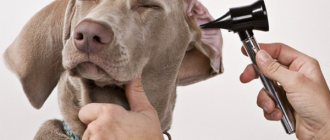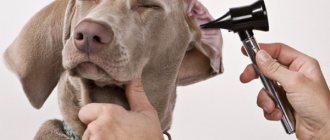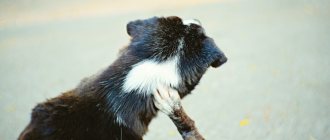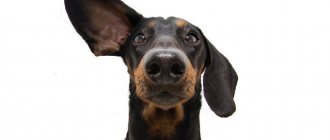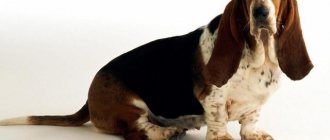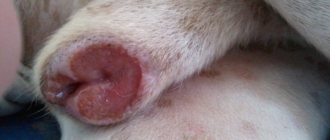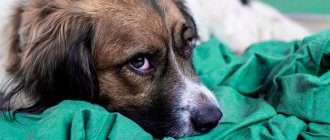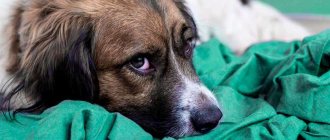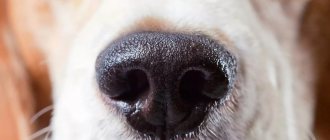Due to the specific structure of the ear, dogs are often susceptible to otitis media. Inflammation of the middle ear in dogs is often diagnosed; internal and external are less common.
The disease causes discomfort and severe pain to the pet. A visit to the veterinarian will help free the dog from uncomfortable sensations and prevent it from developing into a chronic form. An advanced disease can develop into complete deafness and provoke the death of a pet.
Why does otitis media develop in dogs?
There are a number of main reasons for the development of otitis media in dogs.
Regular ear cleaning is the best prevention for otitis media.
- Decreased immunity. Low activity of the pet's immune system leads to a weakening of the protective function of the skin. As a result, numerous microorganisms and fungus multiply in the ears, and inflammation develops.
- Presence of fur in the ears. Too thick hair in a dog's ears has several negative effects: it interferes with the removal of excess wax from the ear canal, blocks the access of air (stagnation and waterlogging occurs), irritates the skin, leading to increased work of the ear glands.
- Neoplasms in the ear. Growths in the ear canal can interfere with ventilation, bleed, fester, causing an active increase in the number of pathogenic microbes.
- Allergy. Allergic reactions cause otitis media by increasing the secretion of sulfur and reducing local immunity.
- Ear mite. Damages the skin of the ear canal, causing inflammation.
- Proliferation of cartilage and skin folds. This feature is typical for dogs of certain breeds, for example, Shar-Pei. As a result of an excessive increase in the size of the folds in the ear canal, gas exchange in it is disrupted.
- Water penetration. Stagnation of fluid in the ear promotes the proliferation of pathogenic microorganisms.
- Entry of a foreign body. If a foreign object gets stuck in a dog’s ear, the air supply will stop, irritation of the nerve endings will begin, excessive amounts of wax will be released, and bacteria will grow.
- Hormonal disbalance. Any endocrine disorders can cause excessive secretion of sulfur, reducing local defenses.
- Poor nutrition. Excessive amounts of simple sugars (sweets) in your pet's diet result in their presence in the sulfur produced. Released in increased volume, it becomes a breeding ground for infection.
- Heredity. Animals with floppy ears (spaniels), excessively open shells (shepherd dogs) and prone to allergies are more likely to develop otitis than others.
Predisposition of certain breeds to otitis media
Some breeds are more prone to this disease. Most often - dogs with large drooping ears: cocker spaniel, basset hound, dachshund and others. Drooping ears obscure the auditory opening and interfere with “ventilation,” which creates a “paradise” for the reproduction and life of pathogenic microbes.
East European Shepherds also often suffer from this disease. The structure of the ear does not prevent the penetration of dust and microorganisms into it.
Dogs with expressive folds on the muzzle, active swimmers, and those who live in high humidity climates are also at risk.
Photo of otitis media in dogs
Nerves of the middle ear
Some of the nerves are closely connected to the middle ear:
- The internal carotid nerves provide sympathetic postganglionic innervation to the eye and orbit. In cats, they are located under the mucous membrane and are therefore easily damaged, leading to Horner's syndrome (enophthalmos, ptosis and miosis) (Fig. 5).
- Facial nerve. Damage to the facial nerve can lead to blepharospasm and paralysis of the auricle or facial muscles.
- The tympanic branch of the glossopharyngeal nerve transmits pain and pressure impulses from the middle ear.
The external carotid artery (red arrow) and maxillary vein (blue arrow) are located ventral to the horizontal canal (yellow arrow). The facial nerve (green arrows) surrounds the ventral two-thirds of the canal (Fig. 6).
Video Damage to the facial nerve.
How does otitis media manifest in dogs?
Symptoms of otitis in a dog can be varied, the degree and form of their severity depends on the type of disease, immunity, individual characteristics of the pet, and the neglect of the process. The owner should contact the clinic if he notices the following symptoms:
- the animal shakes its head or scratches its ears frequently;
- the pet does not allow you to touch its ears;
- discharge appeared from the external auditory canal;
- the dog whines when he tries to scratch his ears;
- too much sulfur in the passage;
- at the beginning of the ear canal, hair falls out, ulcers, redness, and wounds appear;
- the lymph nodes under the animal’s jaw are enlarged;
- the ears are hot to the touch, and swelling is observed.
As the pathological process develops, the pet’s overall body temperature rises and he refuses to eat.
In some cases, the predominance of one or another symptom may indicate the cause of otitis media.
Cause
Symptom
Wool
Hair growing deep
Ear mite
There are dark-colored crusts on the surface of the skin of the auricle and ear canal. When they are removed, wounds can be distinguished
Bacteria, fungi
Skin swelling, redness, suppuration, increased local and general temperature
Water
Liquid discharge from the ears
Allergy
The appearance of an allergic reaction in other parts of the body
How to use ear drops correctly
To increase the effectiveness of treatment, it is important to follow several rules:
- Before you put drops in your dog's ears, you need to clean them thoroughly. To do this, you can use antiseptic ear drops, which are usually used for hygienic purposes. After this, softened dirt, scabs, etc. must be carefully removed using a cotton swab or pad.
- The required number of drops is applied to each ear. After this, you should close the ear canal with the free edges of drooping ears or bring the edges of the ears together if they are erect. And lightly massage the ears at the base so that the solution is better distributed over the inner surface.
- If the dog tries to shake its head after the procedure, it must be restrained from doing so for several minutes. Otherwise, she may shake the medicinal solution out of her ears.
- During the cold season, you should not take your dog out for a walk until the ears are dry.
These simple rules will help make the course of treatment more effective and speed up your pet’s recovery.
Types of otitis media in dogs
There are several classifications of otitis media in dogs.
By origin
- Primary. Develops independently (hypothermia).
- Secondary. It is a consequence of any disorders, for example, hormonal ones.
By localization
- Otitis externa.
- Otitis media.
- Internal otitis. The most dangerous, since the eardrum and cartilage tissue become inflamed. There is a threat of sepsis and spread of the process to the brain.
By the nature of the discharge
- Purulent.
- Exudative (a lot of sulfur is released).
With the flow
- Spicy. It is characterized by severe pain and a sharp development of symptoms.
- Chronic otitis media. Has vague symptoms. It is characterized by a long course with alternating periods of exacerbation and remission.
According to the source of inflammation
- Fungal. The fungus multiplies very intensively, so the disease quickly spreads to the inner ear. The symptoms are pronounced, which brings anxiety and pain to the pet.
- Bacterial. Accompanied by an increase in temperature and the formation of crusts on the surface of the ear canal.
- Malassezia otitis media. Refers to fungal types of otitis. The causative agent is Malassezia. It is present on the surface of the skin of the dog’s ear, but manifests itself only when the body’s defenses are reduced. Often accompanied by a bacterial infection.
- Allergic. Manifests itself in swelling, itching, redness of tissues. Does not respond to antifungal and antibacterial drugs. An allergy can be suspected if similar symptoms are found in other parts of the body.
- Verrucous otitis media (warty). Numerous warts and growths form on the surface of the dog’s ear skin, which gradually block the ear canal, leading to inflammation.
Important: to diagnose the type of otitis in a dog, it is better to consult a specialist. Only laboratory tests can accurately indicate the cause of the disease. Self-selection of medications can cause complications, including deafness or inflammation of the meninges and the death of the pet.
Complications and consequences
The main danger of the disease is the possible rupture or dissolution of the eardrum due to the abundance of purulent discharge. Penetration of pus into the inner ear is fraught with hearing loss or death from purulent meningitis. Surgical operations on brain tissue associated with the ears are no less dangerous. In an attempt to save the animal, the surgeon may touch the nerve endings responsible for motor function. After this, the pet will forever remain disabled.
How to diagnose
Examination by a veterinarian
At the veterinary clinic, the owner will need to not only show the dog to a specialist, but also answer a number of questions. Of great importance for making a diagnosis are: diet (predominant product or feed), walking habits, presence or absence of vaccinations, chronic diseases. You will need to remember when the symptoms appeared, what the nature of the disease is, the behavior of the animal and other nuances.
For diagnosis, a veterinarian may prescribe the following types of examinations:
- blood tests, discharge from the ear canal;
- scraping from the ear;
- x-ray (if a foreign object is suspected);
- tomography (to assess the condition of the inner ear, meninges).
Symptoms
The following symptoms help determine the presence of purulent otitis media:
- redness, swelling of the ear;
- hearing impairment;
- discharge of pus from the ear with an unpleasant odor;
- increased body temperature;
- vomit;
- the pet touches a sore spot, tilts its head, does not tolerate having its ear touched;
- decreased appetite;
- lethargy;
- impaired coordination of movements.
The pet lies down a lot, refuses to eat, and whines. The affected ear begins to droop and the lower jaw becomes displaced. In severe cases, nausea, vomiting, and convulsions occur.
Treatment of otitis media in dogs
Treatment of otitis media in dogs is complex. The conservative approach includes a number of areas:
- eliminating the cause (if possible);
- relieving swelling, itching, pain;
- getting rid of crusts, discharge, external treatment;
- detoxification of the pet's body;
- destruction of pathogenic microbes in the ear and throughout the body;
- strengthening the immune system.
If we are talking about overgrowing of the ear canal, tumors, or a foreign body, then surgical intervention is possible.
Due to the variety of forms of ear inflammation in dogs, treatment will vary. Thus, for chronic otitis, in addition to antibacterial drugs prescribed during an exacerbation, it is recommended to use drops to prevent the growth of fungi and bacteria. Fungal otitis requires the use of antimycotic agents, and bacterial inflammation is treated with antibiotics. When diagnosing allergic otitis, first of all, a strict diet and antihistamines are prescribed.
Types of ear drops
Preparations for auricular application are distinguished by composition and, accordingly, action.
Antibacterial
This group of drugs is intended for the treatment of diseases caused by bacteria or occurring with bacterial complications. As a rule, modern ear drops use broad-spectrum antibiotics that are highly active against most pathogens.
Anti-inflammatory
Such drugs are used in the treatment of non-infectious inflammation of the ears as an independent remedy, as well as in combination with other medicinal substances (for example, antibacterial ones). Anti-inflammatory drugs reduce itching and swelling in the pathological focus, promote the healing of wounds and other tissue damage.
Antifungal
Contains fungicides that attack microscopic fungi such as candida and malassezia. These microorganisms often colonize the inner surface of the ear.
Insectoacaricidal
Such drops are used in the treatment of otodectosis and other ear diseases caused by parasites.
Combined
Drugs in this group are effective for ear diseases caused or complicated by different types of pathogens. Thus, Anandin Plus drops from AVZ have an insectoacaricidal effect, suppress the inflammatory process, and are distinguished by antimicrobial and antifungal activity.
Complications of otitis media in dogs
Failure to consult a veterinarian in a timely manner or the sudden and rapid development of an infection can lead to dangerous complications, which is especially typical for bacterial otitis. In addition to the disease becoming chronic, the dog may have the following consequences:
- hearing impairment, deafness;
- inflammation of the membranes of the brain;
- neurological disorders;
- psychical deviations;
- swelling of the inner ear;
- purulent eye lesions, strabismus.
What is the difference?
Purulent otitis is an inflammatory disease affecting the outer, middle and inner ear. The deeper the disease penetrates, the more seriously the hearing system suffers, and the risk of partial or complete hearing loss increases.
Develops as a complication of an infectious, fungal or parasitic disease. It differs from other types of pathology in the release of pus with an unpleasant odor. The animal's condition instantly deteriorates, which manifests itself in the form of increased body temperature and vomiting.
Features of treatment at home
Even if the owner knows how to treat a particular type of otitis in a dog, ear therapy at home should only be done after the pathogen has been identified. You should not immediately stuff your pet with antibiotics or instill the first drops that come to hand. Such “treatment” can lead to a deterioration in the animal’s condition.
Treatment of otitis media in dogs at home
What other rules must be followed when treating an animal at home? First, cleaning your ears should be done using a swab, not a stick. Due to its small size, it is impossible to fully hygiene the auricle and ear canal.
The owner must have the skills to clean the animal's ears, especially if the breed has a tortuous ear canal, there are numerous folds and cartilaginous growths. There is a high probability of causing pain in the dog through inept actions. In addition, if there are growths and folds, it will not be possible to properly see the surface of the skin and carry out hygiene.
Some owners believe that hydrogen peroxide should be instilled into the animal’s ear so that it “dissolves” deposits, which can then be easily removed. In fact, the solution is intended only for treating the sink. Penetrating into the ear and contacting pus, damaged surfaces, and wax, peroxide foams, leading to specific sounds in the ears. The animal may get scared.
All that is required from the owner is to provide the dog with peace, adequate competent treatment, adequate nutrition and attention.
Drops for otitis media
For the complex treatment of fungal otitis, drugs are prescribed that include miconazole, clotrimazole or nystatin.
The following anti-otitis drops for dogs are recommended for use:
- Surolan is an antimicrobial, anti-inflammatory and antiparasitic agent. You can use 3-5 drops twice a day. The course of treatment is 2-3 weeks.
- Aurizon fights bacteria and fungi. Apply 10 drops once a day for 1 week; if the symptoms do not disappear, the treatment is extended for the same period. Contraindicated for bitches expecting puppies.
- Otonazole is an antipruritic, antifungal agent. Use 3-5 drops once a day for 2 weeks.
- If the inflammation is caused by an allergen, antihistamine ear drops for dogs are used for otitis media.
- Sofradex – 2-3 drops, 3-4 times a day. Helps very well with swelling and itching.
- Anauran – 5 drops, 2-4 times a day. Indispensable for swelling and itching.
Treatment for suppurative otitis media in dogs is best done with antibiotic ear drops for dogs.
For example:
- Otibiovet – 4-5 drops. At the beginning of the development of the disease 3-4 times a day, after 3 days 2-3 times.
- Otipax – 4 drops, apply 2-3 times a day for ten days.
- Anandin , the dose here depends on the size of the pet. Dwarf breeds need 3 drops, medium breeds need 4 drops, and large breeds need 5 drops. The medicine is used for 3-4 days twice a day. It is required to repeat the course in a week, unless otherwise prescribed by your doctor.
The parasitic form requires treatment with insectoacaricidal agents.
- Leopard - 3 drops for dwarf dogs, 4 drops for medium-sized dogs and 5 drops for large dogs. Treatment is carried out twice with an interval of a week.
- Amitrazine is used once a day with an interval of 3 days. The procedure must be carried out until the signs disappear.
Otitis resulting from injury is treated with drugs that promote wound healing:
- Otopedin . Since these ear drops for dogs are quite toxic, the ears are treated once a week with 2-3 drops. After manipulation, the ears are fixed open for twenty minutes.
- Aurican needs to be dripped 5 drops for small dogs, 10-15 for medium-sized dogs, and 20 to 30 drops for large dogs. The drug is used daily for a week, then twice a week for another 25-30 days.
To make ear drops for dogs more effective, you need to follow some rules:
- Before the procedure, clean your pet’s ears;
- Warm the drops in the palm of your hand before use;
- when instilling, you need to pull the ear towards the spine, then press and massage a little.
What can you do before visiting the veterinarian?
If you cannot immediately seek help from a veterinarian, you can take several independent measures that will alleviate the dog’s condition.
- Inspect the concha and external auditory canal. This must be done carefully so as not to cause pain to the animal.
- If there are damages, treat them with a swab dipped in hydrogen peroxide.
- Otinum can be instilled into the ear. This product is not dangerous to the dog's health. It will help eliminate pain, itching, and soften deposits. It is better not to use other drops or ear ointment before a doctor’s examination and diagnosis, so as not to accidentally contribute to the resistance of microorganisms to further treatment.
- If your pet is febrile, you can give him an antipyretic drug, such as paracetamol.
May your dog's ears be healthy!
In puppies
As a preventive measure, it is recommended to carefully monitor the health of dogs’ ears, their cleanliness, and increase immunity with the help of a balanced diet. After the walk, the ears are inspected and dirt and insects are removed.
This especially applies to puppies, who are more active and run around in bushes and tall grass during walks, where there may be dangerous insects.
Prevention of otitis in dogs
Minor restrictions and rules for caring for your dog will help prevent the development of otitis media.
- The better the immune system, the less susceptible the dog is to infections and parasites. A nutritious diet and walks will help strengthen the body's defenses.
- Regular cleaning of the ear shells 1-2 times every 7-10 days is indicated not only as a hygienic procedure, but also as a preventive procedure (detection of the disease at an early stage).
- Hypothermia of the animal should be avoided.
- After water procedures (at home or in a pond), excess water should be removed by blotting the ear with a swab and tilting the dog’s head to the side.
- It is not advisable to let your pet go outside alone. The animal may be injured and may also “meet” other dogs infected with ear mites, fungal or other infections.
Attentive attitude towards your four-legged friend and, in case of otitis, a timely visit to the veterinary clinic will be the key to the health of the dog’s ears and the entire body.
Treatment with medications
Let's look at several effective schemes for treating otitis media in a dog. The proposed life examples will help you navigate and build the right treatment for your pet.
Option 1
Patient: large dog, weight 40 kg, age 4 years. Owner's complaints: does not allow petting on the head, the dog's ear hurts. Diagnosis: exudative otitis externa.
Local processing:
- Hydrogen peroxide. Using a damp swab, wipe the inside of the ear and the passage. Cleansing from crusts, pus and excess sulfur.
- Chlorhexidine. Wipe the ear treated with peroxide twice a day for half a month.
- Bepanten. Apply the ointment to the inside of the ear 2 times every 24 hours, for a course of two weeks. In severe situations, it is allowed to use Fluorocort or Lorinden.
- Sofradex - inject 3-5 drops into both ears twice a day for 14 days.
Parallel treatment:
- Sinulox or Clamoxil. Inject into the thigh once in the morning, 5-7 days, 4 ml.
- Suprastin. In the withers - inject 1 ml in the morning and evening - a weekly course.
- Serrata. It is necessary to inject 1 pill twice with an interval of 12 hours – 10 days.
Option 2
Patient: male, age – 7 years, weight – 12 kg. Owner's complaints: the dog is restless, his ear is leaking. Diagnosis: purulent otitis media in the chronic stage.
Local processing:
- Peroxide - twice a day, two weeks.
- Chlorhexidine - twice a day treatment for up to two weeks.
- Bepanten - twice a day for two weeks.
- Sofradex – 3-5 drops every 12 hours. The course of treatment is two weeks.
In a difficult situation, the following mixture of drops is acceptable:
Ceftriaxone 1 bottle + Dioxidin 10 ml + 5 ml Novocaine 0.5% + Suprastin 2 ml + Dexomethasone 3 ml + vitamin B12 2 ml + Dimexide 0.5-1 ml. This suspension should be administered 3-5 drops into both ears with a 12-hour interval. The course of treatment lasts 14 days.
At night, you need to apply a gauze swab soaked in the mixture: 2 ml of Lincomycin, 1 ml of Dexamethasone, Suprastin 1 ml and Novocaine 2% 3 ml. Treatment should continue for 10 nights.
Parallel treatment:
- Sinulox – intramuscularly 3 ml once, course of treatment – a week. Let’s say 1 bottle of Cefogram is mixed with Lidocaine 8 mg. Inject 2.5 ml of the prepared drug 1-2 times a day.
- Suprastin - inject 0.5 ml into the outer thigh, morning and evening for 7 days.
- Serrata - twice a capsule - no longer than 10 days.
- Liarsin – 1 pill 2 times a day – 10 days.
- Mezim – take 1 capsule twice a day for 12-14 days.
A blockade with novocaine at the root of the ear may also be useful. For this, novocaine 05% is used, 7 ml twice a day. Treatment duration is 1 week.
Antibiotics for otitis in dogs should be taken with caution, for example, if the eardrum is damaged, drops containing an ototoxic antibiotic are contraindicated.
Clinical picture
The animal may exhibit the following signs of disease:
- the dog constantly itches, tilts its head, shakes it differently;
- due to pain, the animal does not allow you to touch its head;
- unusual discharge may be observed from the ear canal, the ears turn red;
- if you press on the ears, you can hear a characteristic squelching sound;
- you can notice scratching on the animal’s head;
- sick puppies have hot ears;
- submandibular lymph nodes are often enlarged;
- the pet’s general well-being suffers: the pet becomes irritable, and the animal loses weight due to poor appetite;
- when opening the dog's mouth it hurts;
- the skin at the site of otitis becomes lumpy and thickens.
